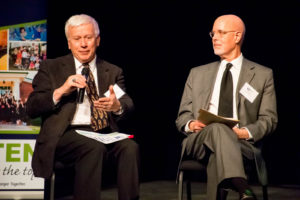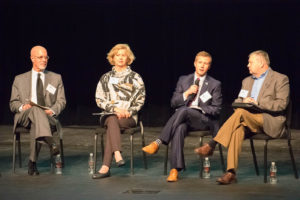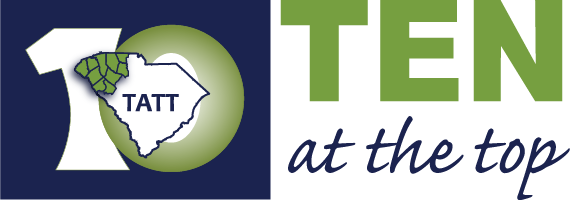Feb 19, 2018 | Staying on Top
By: Sue Schneider, Board Chair, Ten at the Top
Please go on a quick journey with me: Just imagine that for every second it takes to read the first paragraph of this letter, a cherry-red Tesla Roadster is moving seven miles closer to the asteroid belt in a thousand-year voyage to a new horizon. But this is not from a sci-fi story that takes place in the distant future—it’s actually happening. This very moment.
Elon Musk has captured our imagination on space travel and his Space-X launches continue to excite and engage us in the idea of heading to the stars, providing us all with a glimpse of the not-too-distant future. There’s that word—another that we need to reclaim and redefine. Like “community,” the word itself, “future,” also seems to be struggling under the weight of overuse. In the Upstate, we can’t afford to think of our future as a bland and unexciting destination. The future, however, is not just a place in time, or a destination. It’s a goal. An idea. A risk. A challenge. An opportunity.
We all want an amazing future in the Upstate. That’s why Ten at the Top is convening the ultimate game changer: The Connecting Our Future initiative. The kick-off event launched last October to create a regional vision for transportation, mobility, and connectivity in the 10-county Upstate. An advisory committee comprised of stakeholders representing education, transit systems, local governments, economic development organizations, health care, conservation groups and businesses is working closely with Kimley-Horn consultants to develop a regional vision and actionable strategies for transportation, mobility and connectivity.
Connecting Our Future is addressing these goals:
Reduced congestion
Increased connectivity and mobility
Moving people and freight across the region safely
Improving quality of life and health of Upstate residents by reducing emissions
The idea of tackling mobility in the Upstate is the Best. Idea. Ever. How frustrating is it to see where we need to be going but we can’t get there? Think of the countless hours we might sit in an Interstate-85 traffic jam: Your exit is within sight but traffic is stalled. While a space car is moving at a rate of seven miles per second, it can seem like a thousand-year journey to travel just across the Upstate.
But developing a collective vision for mobility in the Upstate is not just about traffic congestion; it is really about ensuring that we plan for a future that provides accessibility to work and play for all of our citizens. Transportation is an equalizer and levels the playing ground for everyone; it can also mean the delivery of an economic advantage that provides us lift-off—the rocket fuel to propel more jobs and us to new investment. This will help us create a region that can move people, goods and services while maintaining—and enhancing—our collective quality of life.
A rollout event is planned for June, but you can get involved now. Please consider participating in the upcoming Stakeholder Symposium:
Stakeholder Symposium
March 19, 2018
1:30-4:30 p.m.
The Michelin Conference Center
517 Michelin Road, Bldg. 18
Greenville, SC 29605
As leaders and community members we are creating the future that we want by redefining what it means. And just like the space car, that future we all seek is inching closer and closer to us by the second.
A new horizon is just up ahead. Let’s find that future before it finds us.
Feb 13, 2018 | Uncategorized
GREENVILLE, S.C.— Ten at the Top is pleased to announce the addition of two new staff members, Adelyn Nottingham and Dewey Evans, both of whom will serve as Program Managers for the organization. Ten at the Top is a nonprofit organization focused on promoting collaboration and strategic planning across the Upstate region.
Adelyn joins the TATT team after working for The Haven Homeless Shelter in Spartanburg, South Carolina. She previously served as in the Americorps Vista program through the United Way of the Piedmont working specifically with the Know(2) Program in Cherokee County. Due to her experience in enhancing the quality of life for community members, her efforts will focus on Human Potential, specifically on The Pique, a young professional development initiative, as well as issues facing Upstate seniors. She is also serving as the lead program manager for the Connecting Our Future Transportation, Mobility and Connectivity initiative. Originally from West Virginia, she now makes her home in Spartanburg, South Carolina.
Dewey will coordinate the efforts around Economic & Entrepreneurial Vitality, Sustainable Growth and Community Vibrancy. These areas will focus on improving the Upstate’s entrepreneurial ecosystem, encouraging responsible future growth and embracing the cultural heritage of the Upstate. He comes to TATT with a strong desire to make an impact in the economic and community development arena and is excited to contribute to the Upstate’s regional development strategy. A graduate of Appalachian State University and Pickens High School, Evans currently resides in Easley, South Carolina.
“To ensure that Ten at the Top is appropriately structured to continue accomplishing our mission to build the collective capacity of the region around issues that impact economic vitality and quality of life, we felt it was important to focus as much of our staff resources as possible around our programs and initiatives,” Dean Hybl, TATT Executive Director, said. “Thus, we are doubling our staff of program managers and are very fortunate to have two young professionals with a familiarity for the region as well as a passion for making the Upstate a better place to live, learn, do business and raise a family.”
About Ten at the Top
Comprised of public, private and civic leaders from across the ten-county Upstate South Carolina Region, Ten at the Top was created to connect and encourage regional collaboration through data-driven research and regular convening of leaders and citizens to address key issues facing the region. Ten at the Top works with regional partners to foster collaboration and strategic planning to enhance the economic vitality and quality of life for Upstate residents both today and as the region continues to grow. For more information, visit www.tenatthetop.org.

Feb 7, 2018 | Staying on Top
By Dean Hybl, Executive Director, Ten at the Top
According to a new Upstate Interactive Arts & Culture Map unveiled during Ten at the Top’s January 24th Culture Counts Regional Forum hosted at the Chapman Cultural Center, the 10-county Upstate region is home to more than 1,300 Arts & Culture organizations, venues and programs. Yet, much of the discussion during the forum was that perhaps we don’t do enough to tell the story and leverage the economic and community value of that significant regional investment in cultural activities.
According to Anthony Radich, the event’s keynote speaker and Executive Director of the Western States Arts Federation, “many have ignored the creative economy in the past because for many years the interaction was typically through writing a check and therefore they didn’t see it as something that can generate revenue within the economy.”
However, Radich added, that has changed in recent years as “a lot of focus has been put on the creative economy as something that helps power the overall economy in a state or region.”

Anthony Radich, Keynote Speaker (Left)
Radich credits the growing number of economic impact studies around the role of arts & culture in the economy as helping to change the dynamic. He referenced two specific things that economic impact studies highlight that help illustrate that arts & culture are an important part of local economies.
- Arts organizations and venues employ people who then purchase goods and services and support the economy.
- The studies Identify how arts & culture are related to tourism. Sometimes a specific event can attract people to come to your community, but the studies show that cultural availability as a part of the total package of what attracts people to visit a community is critical.
According to numbers Radich provided during his presentation, the Upstate region has more than 17,500 people employed in what is designated as the creative economy. Looking specifically at Spartanburg, the non-profit creative economy generates more than $32 million in revenue for the local economy.
“Your cultural economy in itself is a medium sized industry,” Radich said. “Communities would love to bring in an industry with an economic impact at the level that the cultural economy provides here in the Upstate.”
Allen Smith, President and CEO of the Spartanburg Area Chamber of Commerce, sees arts and culture as playing an even greater role in providing communities with an advantage when attracting jobs and professional talent. He points to the recent selection of the 20 finalists for the Amazon second headquarters project as an example of the role having a culturally vibrant community plays in shaping a place where people want to live and businesses want to set up shop.
“If you did an overlay of the 20 finalists for the Amazon HQ2,” Smith said, “you would see that they are probably some of the most culturally advanced communities in the nation and I don’t think it is an accident.
“Today, people are choosing place before position. Communities that are winning at recruiting talent are the places that have put a priority on cultural vitality,” Smith added.
Smith said that having tools like the new regional arts & culture asset map is important because attracting professional talent is the number one issue around economic development and is something that we must do regionally.

Panel Discussion
“We have to think of talent recruitment as a regional effort or we will not be successful,” Smith said. “We do just not have the population or resource base as individual communities. We have to create the perception of the Upstate region as a vibrant place where people want to live and work.”
Now that the regional assets map has been developed, the next step will be to leverage the information and resources to help tell the story of the Upstate as a culturally vibrant region and cultural destination.
“We have a region that has everything here from the culture, the history, outdoors,” said Tim Todd, Executive Director of Discover Upstate. “Working together regionally we have to leverage our assets and tell a compelling story of what great assets we have in this region.”
“For a place like Greenwood, being associated with other places like Greenville, Spartanburg and Oconee that have great cultural programs is valuable,” said Anne Craig, Executive Director of the Greenwood Arts Center. “Having information compiled regionally illustrates the totality of the story, instead of looking only at our individual communities.”
Now that the Upstate Interactive Arts & Culture Map has been compiled and unveiled, the next step is taking the information and leveraging it in a way that promotes the Upstate as a cultural destination for potential tourists and potential new residents.
If you are interested in accessing the new Arts & Culture Map or getting involved in the discussion on how to collectively leverage this new resource, go to www.tenatthetop.org.
What: Ten at the Top Upstate Culture Counts Forum
When/Where: January 24th/Chapman Cultural Center, Spartanburg
Who was there: 130+ business and community leaders and residents interested in arts & culture in the Upstate

Feb 6, 2018 | Uncategorized

Sue Schneider, Spartanburg Water
GREENVILLE, S.C.—Sue Schneider, the Executive Director of Spartanburg Water, has been selected as the 2018-2019 Board of Directors Chair for Ten at the Top (TATT). Schneider joined the Board of Directors in 2012 and previously served as the Vice Chair. She follows Hank McCullough of Piedmont Natural Gas, who was the 2016-2017 Chair and will serve as Immediate Past Chair.
Terence Roberts, the Mayor of Anderson, is moving from his role as Board Secretary to Vice Chair. Roberts is also a founding Board Member for Ten at the Top.
Pamela Christopher, the President of the Anderson Area Chamber of Commerce, is assuming the Board Secretary/Treasurer role. Christopher joined the Ten at the Top Board of Directors in 2015.
John Verreault from T.D. Bank and David Feild from Colliers International are serving as Development Co-Chairs. Verreault has been a Ten at the Top Board Member since 2014 and Feild joined the board in 2016.
About Ten at the Top
Comprised of public, private and civic leaders from across the ten-county Upstate South Carolina Region, Ten at the Top was created to connect and encourage regional collaboration through data-driven research and regular convening of leaders and citizens to address key issues facing the region. Ten at the Top works with regional partners to foster collaboration and strategic planning to enhance the economic vitality and quality of life for Upstate residents both today and as the region continues to grow. For more information, visit www.tenatthetop.org.



